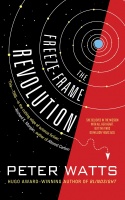After Blindsight, I went on a Peter Watts spree and after reading his masterful short story The Island[a] I ended up with The Freeze-Frame Revolution.

The Freeze-Frame Revolution
Peter Watts
ISBN: 9781616960100
Tachyon Publications, 2018-06
English
I said that I'd love for a book where Watts does what he does best and left out his tics. I can happily report that The Freeze-Frame Revolution is Watts at his best, with none of Watts at his mediocre. The prose is gripping, the scenes are well written, and the whole novelette is trimmed to perfection. (5/5)
The Freeze-Frame Revolution is part of Watts's Sunflowers, which chronicles the travels of the wormhole-gate building ship Eriophora. It's a converted asteroid, powered by a singularity at its center and driven by a Higgs-circuit gravity manipulation drive; and when we join the story it has been circling the Milky Way, building one wormhole-gate after another, for 65 million years. The crew is still the same as it left Earth with. They are kept in hibernation for thousands or hundreds of thousands of years, and only awoken when Chimp, the on-board AI, autopilot, and absolute master of the human crew, needs help with a build or something else unexpected turns up.
The mission is supposed to end when Eriophora receives a recall order. But Earth and humanity appears to be long gone, so Chimp just keeps going, and it's not letting anybody off. They will circle the galaxy at 60,000 kilometers per second and build wormhole-gates until the heat death of the universe, or until Eriophora fails, whatever comes first. Some of the human crew dislikes that plan, and starts to plot the overthrow of their AI master.
In my previous review I said that I'd love for a book where Watts does what he does best and left out his tics. I can happily report that The Freeze-Frame Revolution is Watts at his best, with none of Watts at his mediocre. The prose is gripping, the scenes are well written, and the whole novelette is trimmed to perfection. Unlike Blindsight, where I simply skipped about a third of the book and was much better off, The Freeze-Frame Revolution is lean and mean. It's 41,000 words, and Watts sure makes them count. His portrayal of "deep time" and the alienation of Eri's crew from humanity after millions of years hits you like a sledgehammer, and when you think you've absorbed the blow, you realize you've just repressed the feeling, and it comes back. On top of that are some mysteries that Watts have sprinkled throughout the story, and if there's something that worm(hole)s its way into my mind it is something unexplained.
It's magnificent.
Watts has been criticized for his use of gender-neutral pronouns for one of the characters, which I have stylistic opinions about, and as an IT engineer I find some slight flaws with parts of the plot. But the story is so gripping that I'll happily accept riding over even spine-shattering stylistic bumps in the road and buy in on any level of handwaving if it advances the plot - and by and large, Watts has done his research for the book.
While any science-fiction by its nature is speculative, and any story taking place 65 million years in the future must be speculative indeed, Watts has a reputation for "hard" science fiction: science fiction that at least tries to stay on the plausible side of fantasy. He manages that quite well - unlike for example Egan in Schild's Ladder, he imposes realistic limitations on Eriophora and its crew, and the parts that do deviate into fantasy don't function like a deus ex machina. In fact, with the exception of the drive mechanism, much of what appears fantastic about the Eriophora are in fact at least plausibly possible today.
All in all, The Freeze-Frame Revolution is Peter Watts at his best, and that is good indeed.
1. Sunflowers
The book is part of Watts's Sunflowers, which consists of the following stories as of this writing:
All stories, except The Freeze-Frame Revolution, are available on the author's site[g]. While The Freeze-Frame Revolution can stand on its own, I'd recommend reading Hotshot[h] for clues to some of the mysteries encountered in the book. The Island[i] is worth reading just for its amazing opening paragraphs which really shows off Watts's writing skills; Giants[j] is more of a straight-up science-fantasy adventure story set in the same universe, and I'd rate it the weakest of the set. Hitchhiker[k] is a bonus short that you'd get if you decrypted a secret message in The Freeze-Frame Revolution - but that link is now all over the web so I have no qualms about putting a direct link here.
2. Endnotes
Watts has really done his research, and I recommend looking at the references from the endnotes. In particular, Are Black Hole Starships Possible? by Louis Crane and Shawn Westmoreland[l][1], which clearly is the inspiration for much of the good ship Eriophora. Surprisingly, while the Eriophora is fantasy, it isn't that much of a fantasy. It's a formidable engineering challenge, and perhaps impossible to overcome without several decades of research, but much of the Eriophora is at least compatible with known laws of physics and could in theory be built with known technologies.